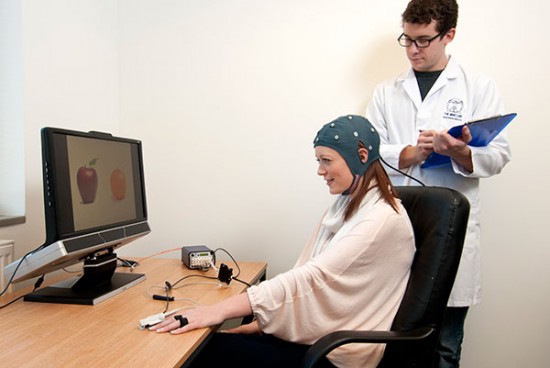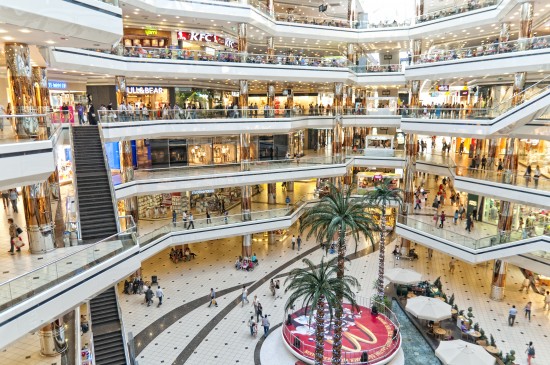How does Mindlab tap into the shopper's desire?
We use a range of technologies, some of which are generally available and others which have been developed in our company. Among these is the EEG, which involves attaching sensors to a person’s head and recording the activity of the brain so that we can gain greater insight below the level of conscious awareness.
We use portable equipment to track consumer’s responses during the purchasing decision whether in store, as they are looking, testing or inspecting products. In addition, we use eye tracking glasses to record precisely where consumers were looking when studying a product, how long they spent on each aspect of that product, and the direction of their gaze. By using a time code, we can then relate these items in images to their brain responses.
Very often we link these brain responses to physical responses, such as heart rate, skin conductance and similar biometric measures which give us an indication of how they are responding both mentally and physically in the situation in which we have an interest. In addition, we use a variety of proprietary tools to measure the responses of people either who are present in the laboratory or responding to our study via the Internet using our virtual lab. This has the advantage of enabling us to recruit a very large number of subjects from any part of the world and in any demographic required by the client.
What can retailers learn from the neuroscience of consumer behavior?
By using neuroscience, retailers can gain a deep insight into the responses of consumers to every aspect of their sales message, including signage (where the details examined might, for example, include the choice of fonts, colors, images, and general design), the attractiveness of displays and how the location of one product on the shelf may benefit or detract from the attractiveness of its neighbor. We are especially interested in understanding the emotional responses of consumers, since many purchasing decisions are a result of emotions rather than rational thought.
Retailers can also learn about the cognitive flow, the ease with which a purchase can be made. Anything which interrupts the flow of a transaction is likely to significantly to reduce or even terminate the consumer’s interest in acquiring that particular item. By analysing cognitive flow and identifying bottlenecks in the purchasing process, we are able to significantly enhance the likelihood of a successful sale. This applies to both clicks and bricks.
The neuroscience of consumer behavior helps with the humanics and mechanics. Humanics refers to the interactions of the customer with sales agents, from the initial meeting to closing the deal. The more empathic, informed, and skilled the sales agent, and the better the rapport built with the customer, the greater the chances of success. Mechanics refers to atmospherics (aromas, lighting, architectural design, ambiance, color, etc), the entire physical mechanism by which and in which the sale is transacted.
How would you describe today's typical shopping behavior?
The modern consumer is more knowledgeable, as a result of the information now available on the Internet and has the tendency, especially younger consumers, to do considerable research using the Internet before making a purchase in a physical, retail environment. However, he/she is also far less patient. Anything which causes him/her to be delayed or distracted, in other words to encounter increased cognitive load can significantly detract from the probabilities of a sale.
How do the hidden persuaders work in brick-and-mortar stores?
The hidden persuaders work in a wide range of ways: from triggering memories and evoking emotions through the use of aromas to the use of priming techniques which trigger memories of and desires for a particular product.
In your opinion, what trends will dominate the retail market in the future?
There is a great desire among consumers to purchase products which are authentic, unique, individual to them, and part of their identity as sophisticated and knowledgeable consumers. Another trend will be the personalization of advertising and marketing messages. I believe that, increasingly, marketing and advertising will be done by computers and not by humans. Computers will be able to deliver messages at the most appropriate moment in order to maximize the probability of a sale. For example, you are walking down the street and you feel hungry. Your mobile phone knows both the time and your location. A computer program can send a message to the phone, having first extracted information as to your location from the phone. Personalization will extend to billboards. At present, there are billboards which know
your approximate age and sex, and use this information to deliver more personal information. This technology which is currently close to being developed will enable the billboard to use information from your social media pages and create messages directed solely for your attention.
Do you think the concept of entertainment in shopping centers will see further development?
There are two forms of shopping, going shopping and doing the shopping.
When we are doing the shopping, we are looking for convenience, speed and, increasingly, the best possible price. Going shopping, however, is a major leisure activity and we want to be as much entertained as directly sold to. More and more retail premises recognize the importance of entertainment in shopping centers. This means that every aspect of the shopping experience must be carefully controlled from arrival to departure.
Modern airports can reasonably be described as shopping malls with runways attached. Shopping at airports helps to fill the time between flights in an agreeable way rather than a boring one. There is a constant buzz and excitement.
I have no doubt that more and more retailers will recognize the concept of entertainment as an essential part of shopping experience, whether they provide free fashion shows, music, art displays etc. or include actual theme park rides and similar attractions to the ones found in many of major shopping malls such as the ones in US, Canada, Dubai just to name a few.


















